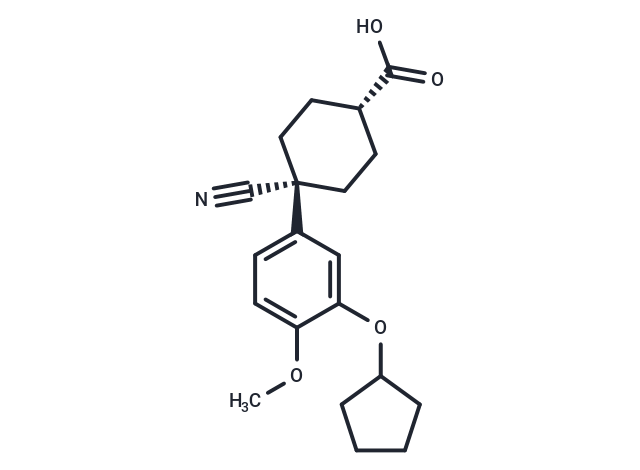Shopping Cart
- Remove All
 Your shopping cart is currently empty
Your shopping cart is currently empty

Cilomilast (SB-207499) is a potent PDE4 inhibitor with an IC50 of approximately 110 nM, demonstrating anti-inflammatory activity and minimal central nervous system effects. Phase 3.

| Pack Size | Price | Availability | Quantity |
|---|---|---|---|
| 5 mg | $48 | In Stock | |
| 10 mg | $89 | In Stock | |
| 25 mg | $161 | In Stock | |
| 50 mg | $286 | In Stock | |
| 100 mg | $419 | In Stock | |
| 1 mL x 10 mM (in DMSO) | $53 | In Stock |
| Description | Cilomilast (SB-207499) is a potent PDE4 inhibitor with an IC50 of approximately 110 nM, demonstrating anti-inflammatory activity and minimal central nervous system effects. Phase 3. |
| Targets&IC50 | LPDE4:100 nM |
| In vitro | Cilomilast produces a concentration-dependent increase in cAMP content in U937 cells. Cilomilast produces a concentration-dependent increase in cAMP content in U937 cells. [2] In isolated human monocytes, Cilomilast and (R)-rolipram are equipotent at suppressing LPS-induced TNF-α formation with -log (IC50) of 7.0 and 7.2, respectively. Both Cilomilast and (R)-rolipram produces a modest prevention of fMLP-induced degranulation of human neutrophils. Cilomilast and (R)-rolipram are equipotent at suppressing neutrophil activation with -log (IC50) of 7.1 and 6.4, respectively. [2] Cilomilast significantly decreases the expression of TNF-α in the cornea and IL-1α, IL-1β, and TNF-α in the conjunctivaas compared to vehicle control. Cilomilast treatment markedly decreases the presence of CD11b+ antigen-presenting cells in the central and peripheral cornea, and leads to decreased conjunctival expression of cytokines IL-6, IL-23, and IL-17. Moreover, Cilomilast decreases the expression of IL-17 and IL-23 in the draining lymph nodes. [3] Cilomilast reduces TLR4 expression, IL-8 release and neutrophil chemotactic activity as well as it increased IP-10 release and lymphocyte chemotactic activity. [4] |
| In vivo | Cilomilast inhibits human TNFα production with oral ED50 of 4.9 mg/kg. In contrast to their equipotent activity against TNFα production, Cilomilast (ED50 = 2.3 mg/kg, p.o.) is 10-fold less potent than R-rolipram (ED50 = 0.23 mg/kg, p.o.) in reversing reserpine-induced hypothermia, a model of antidepressant activity. [1] In time course studies, Cilomilast (30 mg/kg, p.o.) suppresses TNFα production for at least 10 hour. The ability of Cilomilast to modulate interleukin-4 productionin vivo is assessed in a chronic oxazolone-induced contact sensitivity model in Balb/c mice. Topical administration of Cilomilast (1000 μg) inhibits intralesional concentrations of interleukin-4. [1] Orally administered cilomilast dose-dependently inhibits production of interleukin-4, TNF-α, and cysteinyl leukotrienes, as well as leukocyte infiltration in bronchoalveolar lavage fluid from the airways of ovalbumin-sensitized Brown Norway rats [5]. |
| Cell Research | U937 cells (1-2 × 10 6) are incubated at 37 °C in a shaking water bath with Cilomilast for 1 min before the addition of 0.1 μM PGE2 (total volume of 200 μL). The incubation proceeds for an additional 4 min and is stopped by the addition of 0.1 mL of HClO4 (17.5%), neutralized with 0.15 ml of K2 |
| Alias | SB-207499, Ariflo |
| Molecular Weight | 343.42 |
| Formula | C20H25NO4 |
| Cas No. | 153259-65-5 |
| Smiles | COc1ccc(cc1OC1CCCC1)[C@]1(CC[C@@H](CC1)C(O)=O)C#N |
| Relative Density. | 1.21 g/cm3 (Predicted) |
| Storage | Powder: -20°C for 3 years | In solvent: -80°C for 1 year | Shipping with blue ice. | ||||||||||||||||||||||||||||||||||||||||
| Solubility Information | Ethanol: 31 mg/mL (90.27 mM), Sonication is recommended. DMSO: 60 mg/mL (174.71 mM), Sonication is recommended. H2O: < 1 mg/mL (insoluble or slightly soluble) | ||||||||||||||||||||||||||||||||||||||||
Solution Preparation Table | |||||||||||||||||||||||||||||||||||||||||
Ethanol/DMSO
DMSO
| |||||||||||||||||||||||||||||||||||||||||

Copyright © 2015-2025 TargetMol Chemicals Inc. All Rights Reserved.